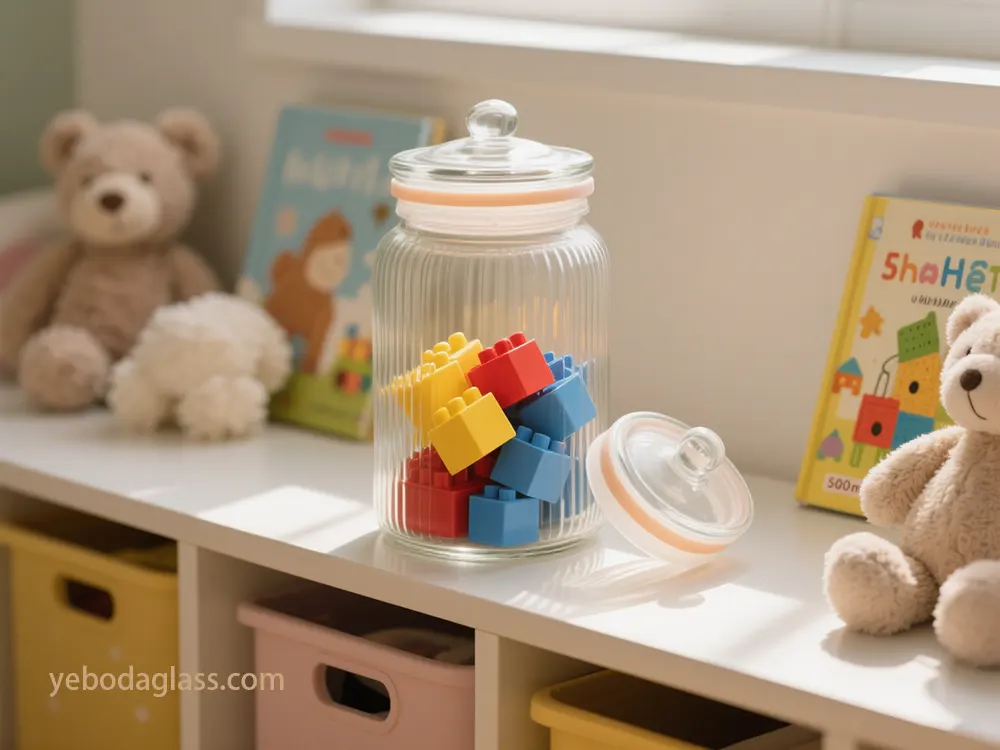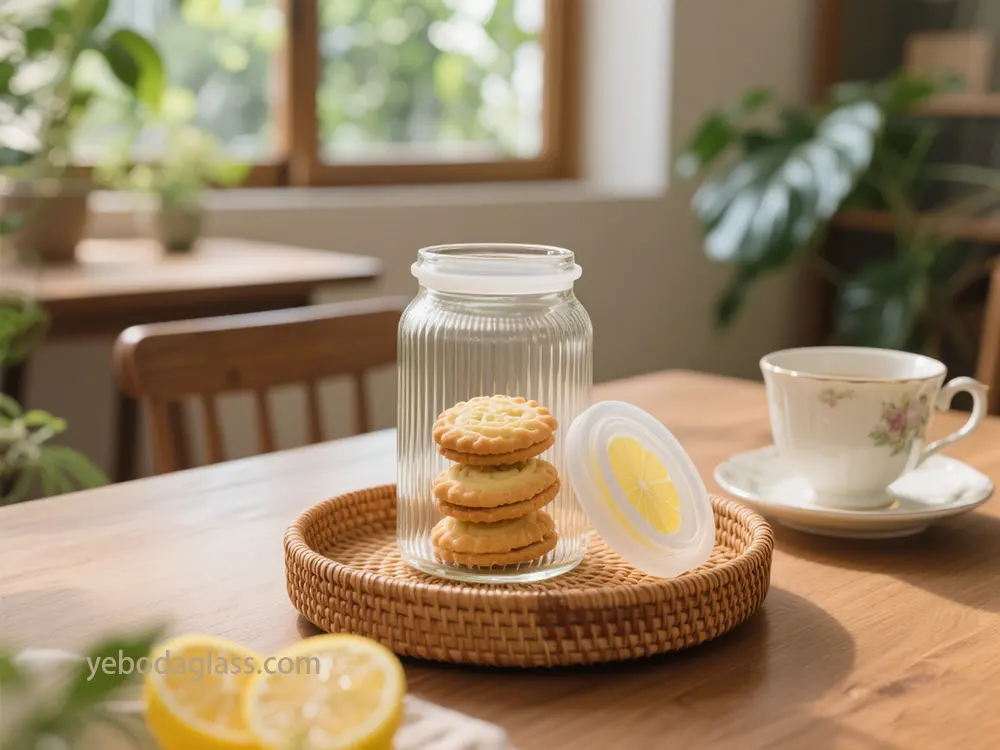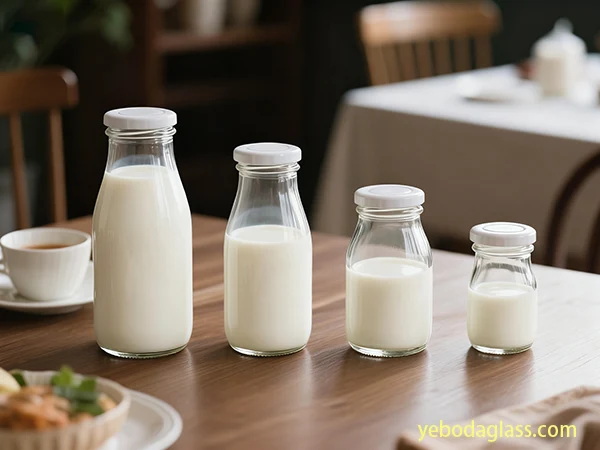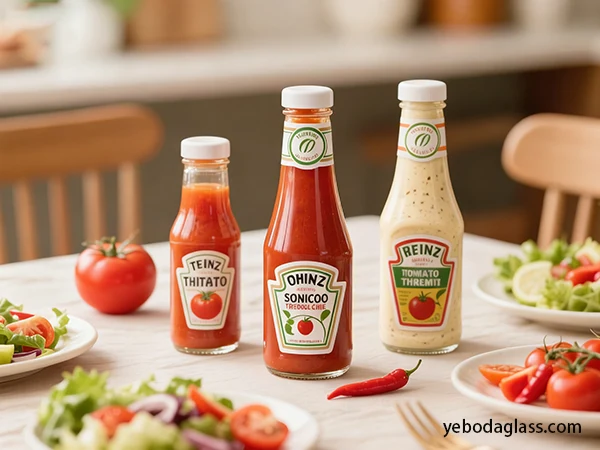유리 상자는 팽창, 그리기, 압축 및 주조를 통해 생산됩니다. 이러한 공정의 정밀성은 최상위 포장에 필요한 완벽한 마감과 일관된 품질을 보장합니다.
Automated traceability maintains material ratios and allows real-time batch adjustments to prevent defects.
Training:
Employees receive systematic training to improve skills and quality awareness, covering raw material selection, batch preparation, and their impact on melting, energy, and glass quality.
4. Manufacturing Process Controls for Physical Integrity
Maintaining glass jar physical integrity during manufacturing is paramount. YEBODA employs in-process controls, monitoring, and quality checks during melting, forming, annealing, and finishing to ensure strength, dimensional accuracy, and defect-free products.
4.1. Melting and Refining Controls
Melting transforms raw materials into molten glass at ~1,500°C.Precise temperature monitoring and control are essential for efficient melting, viscosity, heat zone adjustment, and fining.Advanced Energy (AE) provides pyrometers and thermal imagers for robust, non-contact temperature measurement.Regular furnace maintenance (cleaning, inspection, calibration) is vital for optimal performance and defect prevention.Controlling molten glass redox state significantly influences melting and fining rates, often via sulfate and a reducing agent.Cullet improves batch melting by eliminating the raw material particle solution step.

4.2. Forming Process Controls
During forming, molten glass is shaped into jars. Innovations like the float process have revolutionized glass production, impacting quality and cost.YEBODA uses continuous hot-side product weight measurement (Plunger Process Control – PPC) to prevent fluctuations.Infrared cameras examine temperature distribution and detect defects in real-time.
4.3. Annealing and Finishing
Annealing slowly cools glass to relieve internal stresses, preventing breakage and restoring molecular alignment.Controlled annealing removes thermal tension.After forming and annealing, jars undergo finishing.
4.4. In-line Non-Destructive Testing (NDT) for Defect Prevention
YEBODA integrates advanced in-line NDT for early defect detection.
AI-powered Visual Inspection:
Systems like 3HLE’s RETINA deep learning visual inspector detect cracks and anomalies on reflective/transparent glass jars, replicating human QC at higher speeds without fatigue.Traditional rule-based systems struggle with glass’s reflectivity, leading to high false-positive rate.AI can also optimize mixing/melting parameters for increased mechanical strength and forming ease.
Polariscope Inspection:
Polariscope inspection detects stress/strain patterns in glass using polarized light, revealing quality-compromising inconsistencies.It identifies inclusions (air bubbles/foreign particles) acting as stress concentrators.Polariscope also finds weak points prone to breakage under stress, improving product safety and design.
Acoustic Resonance Testing (ART):
ART detects hairline/micro-cracks in glass, especially for pharma/medical industries.Combined with machine learning, ART distinguishes defective from intact bottles.
Machine Vision Systems:
Emhart Glass Vision inline inspection machines at the cold end detect/reject defective containers before palletization, combining AI and conventional technology.Conventional technology handles simple tasks (e.g., outlining containers), while AI handles complex ones (e.g., wire edge detection, defect classification).
2D/3D Profile Sensors:
These sensors use laser triangulation for 2D height profiles and 3D point clouds for dimensional accuracy.
Resonance Ultrasonic Vibration (RUV):
- This patented methodology is used for crack detection in glass syringe production. Automated Inspection Systems:
- These systems offer significant cost savings by reducing errors and improving throughput.Deep learning models (e.g., CNNs) achieve high accuracy in identifying visible defects like cracks and bubbles.Addressing class imbalance (rare defective products) via data augmentation significantly improves model performance. 5.Chemical Safety and Food-Contact Compliance
- Ensuring glass jars are chemically inert and safe for direct food/pharmaceutical contact is critical for product safety. YEBODA adheres to rigorous testing to prevent chemical migration and maintain product integrity. 5.1. Chemical Inertness and Migration Testing
- Food-contact glass is chemically inert, stable, and doesn’t release significant elements into food/drink.YEBODA follows specific guidelines for conformity testing of glass FCMs, covering container glass, tableware, and cookware. 용해 가능한 요소 및 Schwermetalle:
일반적으로 무기성이지만, 납과 콘돔은 정화제로 인해 소다-석회석 유리 및 보린산 유리에서 방출될 수 있으며, 일반적으로 검출 한도 이하입니다. 납 및 콘돔 검사는 색상 없고 장식되지 않거나 무거리 유리에 대해서는 필수적이지 않을 수 있습니다. YEBODA는 유럽 연합 지침 94/62/EC을 준수하며, 납, 수은 및 콘돔과 같은 Schwermetalle를 제한합니다. 유리 포장은 내재된 안전성으로 인해 더 높은 Schwermetall 함량을 허용합니다 (200ppm 대비 다른 유형의 100ppm).
이동 테스트 표준:
ISO 6486-1:1999 및 ISO 7086-1:2000은 음식 접촉 유리/토기용 납/콘돔 방출 테스트 방법을 설명합니다. 4% 요산을 22°C에서 24시간 동안 사용합니다. 유럽 연합의 전체 이동 한도 (OML)은 총 이동 물질에 적용되며, 특정 이동 한도 (SML)는 독성학적 평가에 따라 개별 물질에 적용됩니다.
FDA 지침:
FDA는 FCS 이동 테스트를 안내하며, 부록 II 프로토콜을 추천하지만 대안을 허용합니다. 테스트는 가장 심한 예상 사용 조건(온도/시간) 하에서 진행됩니다. 실온 응용 프로그램에는 40°C에서 10일간 추천되며, 냉장/냉동 음식에는 20°C입니다.
추출 매체:
약제 제품 용액 추출 성질이 물과 다르다면(예: pH, 첨가제), 약제 제품 자체를 추출 매체로 사용합니다.
QIMA 테스트 서비스:
YEBODA는 식품 포장/접촉 항목의 포괄적인 실험실 테스트를 위해 제3자 QIMA 서비스를 사용합니다. 시각적/측정적 검사, 감각 테스트, 물리적 위험 평가, 색상 누출, 조성, 이동 테스트, NIAS, VOCs, Schwermetalle, 잔여 단량체 및 정화제 분석을 포함합니다.

5.2. 신규 유리 조성 및 표면 처리 테스트 프로토콜
- 신규 유리 조성 또는 표면 처리에 대해 특정 테스트는 화학적 무기성 및 장기적인 안정성을 확인합니다. 물 공격 테스트:
- 이 테스트는 유리 용기(특히 SO2 처리)의 알칼리 저항성을 자동 정화기에서 121°C에서 30분간 물에 담가 침출된 알칼리를 정량하여 결정합니다. 용해도 테스트:
- 이 테스트는 유리의 수소 분해 저항성과 극한 조건에서의 화학적 안정성을 나타내며, 품질 관리(QC) 검사로 사용됩니다. 유리 분말 테스트:
- 이 테스트는 고온(121°C에서 30분간)에서 분말 유리에서 침출된 알칼리를 추정합니다. 아르센ic 테스트:
- 수용액 부식 유리 용기에 대해 이 테스트는 반응 물질 추가 후 흡광도 결정을 포함한 용액 준비를 포함합니다. 유리 분리:
- 유리 분리는 약제 제품과 내부 유리 표면 간의 화학적 상호작용으로 인해 입자가 형성되는 현상으로, 의약품에 있어 중요한 문제입니다. 이는 고온과 pH > 8.0(USP 1660)의 형성 공정으로 가속됩니다. 화학적 내구성 연구는 유리 용기에 저장된 안정성 샘플에서 이를 모니터링합니다. 의약품 유리 유형:
- YEBODA는 화학적 저항성에 따라 의약품 유리 유형을 사용합니다: 타입 I(보린산 유리, 높은 열/화학적 내구성), 타입 II(처리된 소다-석회석, 증가된 화학적 저항성), 타입 III(보통 소다-석회석, 가장 흔한).ISO 주사용 약품 카트리지(ISO 13926-1)는 일반적으로 타입 I 약품 등급 보린산 유리입니다. 6. 생산 후 품질 검증 및 포장
YEBODA의 최종 생산 단계에는 엄격한 생산 후 품질 검증 및 안전한 포장이 포함되어 제품의 무결성을 보장하고 저장/운송 중 오염을 방지합니다.
6.1. 최종 품질 검증
YEBODA는 자동화 및 수동 검사를 결합한 다면적 최종 검사를 실시합니다.
자동 비전 검사 시스템:
- 이 시스템은 포장 항목의 품질을 광범위하게 통제하며, 결함, 라벨 결함, 코드 혼동, 잘못 인쇄된 날짜, 라벨 정렬 오류, 배치 변경 오류, 잘못된 라벨, 표면 오염 및 외관 결함을 고속으로 검출합니다. AI는 인쇄를 자동으로 검사하고 이상을 식별합니다. IC Filling Systems 및 E2M COUTH의 시스템은 병에 대한 시각적 검사를 제공하며, 채워 넣기 전에 병의 선형 공기 병 검사를 통해 상태, 청결도, 외부 물질 및 액체 잔여물을 확인합니다. 고해상도 이미징은 구조, 표면 및 내부 병 결함에 대한 상세한 360도 분석을 위한 초분명한 이미지를 촬영합니다. 컵 검사:
- 컵 검사는 누출을 예방하고 제품의 유통기한을 확보하며 완전한 밀폐와 결함 없는 컵을 확인하는 데 중요합니다. 스트레스 테스트:
- 파라리스코프 검사는 투명 포장의 열 봉제를 검사하며, 스트레스가 있는 지역을 식별합니다. 연속된 색상 줄은 좋은 봉제를 나타내며, 끊어진 줄은 분열된 봉제를 나타냅니다. 유리 파리미터는 편광광선 간섭을 사용하여 내부 스트레스를 확인하며, 유리의 강도에 직접 영향을 미칩니다. 현장 검사:
- 이는 수량/종류 확인, 포장 검사, 안전/낙하 테스트, 측정/크기 확인, 라벨/표시/로고/바코드, 미관/시각적 결함 평가를 포함합니다. 6.2. 안전한 포장 방법
- 안전한 포장은 제품의 무결성을 유지하고 감염을 예방합니다. 충격을 흡수하는 충격제 재료 선택:
보조 포장은 종종 충격제(파이프 카드보드, 성형 종이, 발포재)를 사용하여 운송 충격/진동을 흡수하며, 주로 용기의 취약성, 무게, 비용에 따라 선택됩니다.
방벽 성질:
- 포장 재료는 습기, 먼지, 오염 물질로부터 방호하는 방벽을 제공하며, 필름, 코팅 또는 접합제는 이러한 성질을 향상시킵니다. 최적화된 포장 구성:
- 보조 포장 내부의 용기 배열(예: 상자)은 중요합니다; 분리기, 벽 또는 개별 셀은 용기 간 접촉을 방지하고 파손을 줄입니다. 플랫폼화 전략:
- 연속형 패턴, 스트레치 감싸기, 그리고 스트랩을 사용한 올바른 플랫폼화는 무게를 단위화하고 처리/운송 중 이동을 예방합니다. 환경 제어:
- 단단한 창고 온도/습도 유지는 감습과 라벨 손상을 최소화하며, 특히 민감한 제품에 유리합니다. 성능 테스트:
- 낙하 테스트는 포장의 충격 보호 성능을 평가하며, 다양한 높이/방향에서 포장된 용기를 떨어뜨립니다. 진동 테스트는 운송 진동을 시뮬레이션하여 포장의 약점을 식별하며, 주로 진동대를 사용합니다. 압축 테스트는 압축력을 적용하고 변형을 측정하여 포장이 쌓는 부하를 견디는 능력을 평가합니다. ISTA 표준:
- YEBODA는 포장 성능 테스트에 대한 ISTA 요구 사항을 준수하여 공급망의 엄격한 저항력을 확보합니다. 지속 가능한 포장 솔루션:
지속 가능한 포장에 대한 유행: 재활용 카드보드, 생분해성 충격제, 재료 사용 감소.
7. 추적성, 불합격, 및 회수 관리
YEBODA는 제품 추적성, 불합격, 및 녹색 보관을 위한 강력한 시스템을 구현하여 책임감을 확보하고 안전 문제에 대한 신속한 반응을 보장합니다.
7.1. 엔드투엔드 추적 시스템
- 추적성은 제품의 여정을 원료부터 최종 목적지까지 추적하며, 종합적인 생명주기 이해를 제공합니다. 이는 QC를 향상시키고, 조작물 방지를 돕고, 효율성을 개선하며, 지속 가능성을 지원합니다. 원료 추적:
- 효율적인 원료 추적(시안, 석회석, 소다알칼리, 삭볼)은 중요하며, 강력한 재고 관리 시스템이 양과 위치를 정확히 기록하여 지원합니다. 이러한 시스템은 종종 ERP/MRP와 통합되어 데이터를 중앙 집중화합니다. Batch Record Keeping:
- While “paper-on-glass” systems digitize records, YEBODA moves to fully integrated digital solutions to avoid data silos and ensure real-time validation/audit trails. Unique Identification:
- Barcode scanning tracks losses in real-time, assigning unique barcodes to each batch.QR codes on glassware enable easy LIMS registration, documentation, and traceability, preventing mix-ups and controlling allocation. Electronic Tracking and Reporting:
Electronic tracking systems allow easy reject reporting, immediately flagging issues and notifying personnel automatically.
Vision Inspection Systems:
- High-precision cameras and machine vision systems scrutinize every marked code, ensuring data accuracy and rejecting non-conforming products. Data Management & Software:
- 장벽 속성: 7.2. Non-Conformance Management and Quarantine Procedures
- Non-conformance is any deviation from established specifications, quality standards, regulatory requirements, or internal SOPs.YEBODA categorizes non-conformances (product, process, documentation, supplier). Quarantine Procedures:
- Non-conforming products are immediately coded with a quarantine card and moved to designated zones to prevent production use until disposition.Measures include destruction, reprocessing, correction, or further processing without correction.A timeline is linked to each quarantine for resolution, and a detailed form is completed. Deviation Workflow:
- Deviations are planned, approved changes to test methods, lab, or manufacturing procedures. YEBODA’s deviation management system ensures efficient investigation, reporting, and documentation of deviations, including data and classification (critical, major, minor).Process parameter deviations (e.g., time, temperature, pressure) are closely monitored. 7.3. Product Recall Management
- Blockchain technology significantly advances recall management. Blockchain for Enhanced Traceability:
- Blockchain’s decentralized, immutable nature ensures transparency and trust by recording every transaction on a public ledger.Its consensus mechanism validates data, reducing fraud risk.This enables real-time tracking from raw materials to finished products, significantly speeding up recalls and reducing costs. Fraud and Counterfeiting Prevention:
- Blockchain’s transparency helps prevent fraud, counterfeiting, and other malpractices.It facilitates rapid supply chain issue identification. Isolation of Contamination Sources:
Blockchain allows stakeholders to isolate contaminated ingredient sources and trace their supply chain path.
Cost-Effectiveness and Security:
Blockchain solutions are cost-effective, secure, and provide end-to-end visibility during recalls.Using Polygon EVM can lower gas costs.
NIST Project:
- NIST actively demonstrates blockchain’s role in improving manufacturing supply chain traceability and integrity. 7.4. Integration with Enterprise Systems
- ERP Integration: “종이를 유리에 붙인” 시스템은 기록을 디지털화하지만, YEBODA는 데이터 섬을 피하고 실시간 검증/감사 추적을 보장하기 위해 완전히 통합된 디지털 솔루션으로 나아갑니다.
- 고유 식별: 바코드 스캔은 실시간으로 손실을 추적하며, 각 박테를에 고유한 바코드를 할당합니다. 유리 용기에 있는 QR 코드는 쉬운 LIMS 등록, 문서화 및 추적성을 허용하여 혼동을 방지하고 배분을 제어합니다.
- 전자 추적 및 보고: 전자 추적 시스템은 쉽게 불량 보고를 허용하며, 문제를 즉시 표시하고 인원을 자동으로 통지합니다.
- 시각 검사 시스템: 고정밀 카메라 및 기계 시각 시스템은 모든 표시된 코드를 검토하여 데이터 정확성을 보장하고 비합격 제품을 거부합니다.
- 데이터 관리 및 소프트웨어: 강력한 소프트웨어 플랫폼은 마킹, 검사 및 기타 단계의 데이터를 통합하여 실시간 통찰력과 포괄적인 추적 보고서를 제공합니다.
7.2. 비합격 관리 및 검역 절차
비합격은 설립된 규격, 품질 기준, 규제 요구 사항 또는 내부 SOP에서의 모든 벗어남을 의미합니다. YEBODA는 비합격 사항을 분류합니다 (제품, 프로세스, 문서화, 공급자).
- 검역 절차: 비합격 제품은 즉시 검역 카드로 코드화되고 지정된 구역으로 이동하여 생산 사용을 방지하며 처분까지 검역됩니다. 조치에는 파괴, 재처리, 수정 또는 수정 없이 추가 처리가 포함됩니다. 각 검역에 해결을 위한 타임라인이 연결되고 상세한 양식이 작성됩니다.
- 벗어남 워크플로우: 벗어남은 테스트 방법, 실험실 또는 제조 프로세스에 대한 계획되고 승인된 변경 사항입니다. YEBODA의 벗어남 관리 시스템은 벗어남의 효율적인 조사, 보고 및 문서화를 보장합니다. 데이터와 분류(중요, 주요, 소형)가 포함됩니다. 프로세스 파라미터 벗어남(예: 시간, 온도, 압력)은 엄격히 모니터링됩니다.
7.3. 제품 회수 관리

블록체인 기술은 회수 관리를 크게 발전시킵니다.
- 블록체인을 통한 향상된 추적성: 블록체인의 분산화되고 불변의 특성은 공개 레지스트리에 모든 거래를 기록하여 투명성과 신뢰를 보장합니다. 그의 합의 메커니즘은 데이터를 검증하여 사기 위험을 줄입니다. 이는 원료부터 완제품까지 실시간으로 추적을 가능하게 하여 회수를 크게 가속화하고 비용을 줄입니다.
- 사기 및 가품 방지: 블록체인의 투명성은 사기, 가품 및 기타 부정 행위를 방지하는 데 도움이 됩니다. 그것은 공급망 문제를 신속하게 식별하는 데 도움이 됩니다.
- 오염 원인 분리: 블록체인은 주체들이 오염된 성분 원인을 분리하고 그 공급망 경로를 추적할 수 있게 합니다.
- 비용 효율성 및 보안: 블록체인 솔루션은 비용 효율적이며, 안전하며, 회수 중 종단 간 투명성을 제공합니다. Polygon EVM을 사용하면 가스 비용을 낮출 수 있습니다.
- NIST 프로젝트: NIST는 블록체인이 제조 공급망 추적성과 무결성을 개선하는 역할을 적극적으로 보여줍니다.
7.4. 기업 시스템과의 통합
- ERP 통합: YEBODA는 ERP 시스템을 활용하여 생산, 재고, 판매 및 품질 관리를 최적화합니다.ERP 시스템은 실시간 통찰력을 제공하고 프로세스를 간소화합니다.모듈에는 구매, 판매, 재고, 제조, 물류 및 회계가 포함됩니다.ERP는 API를 통해 MES와 통합되어 원활한 운영을 합니다.
- LIMS 통합: LIMS는 실험실 운영을 자동화하여 효율적인 샘플 추적, 간소화된 보고서 및 생산성 향상을 가능하게 합니다.LIMS는 ERP와 통합되어 공급망 관리를 하고, MES와 통합되어 실시간 품질 지표를 제공합니다.
7.5. 원인 분석 (RCA) 및 교정 및 예방 조치 (CAPA)
- RCA: RCA는 문제를 조사하고, 다양한 원인을 식별하며, 우선순위를 정하고, 해결책을 결정하는 체계적인 프로세스입니다.도구에는 5가지 왜냐고, 이시카와(붕어빵) 다이어그램, 파레토 분석, 히스토그램 및 오류 트리가 포함됩니다.RCA는 효과적인 불량 관리 및 재발 방지에 중요합니다.
- CAPA: CAPA는 알려진 문제를 수정하고 예방하는 품질 관리 전략입니다.이는 FDA가 인정하는 최상위 품질 시스템으로, 프로세스를 개선하고 불량 제품 없이 완료된 제품을 보장하는 것을 목표로 합니다.교정 조치는 근본 원인을 해결하여 재발을 방지하고, 예방 조치는 잠재적 문제를 적극적으로 식별하고 해결합니다.YEBODA는 CAPA를 체계적으로 실행하고 모니터링하여 불량 재발을 제거하고, 준수를 보장하며 지속적인 개선을 합니다.
8. 지속적인 개선 및 위험 관리
YEBODA의 제품 안전 및 준수에 대한 헌신은 강력한 지속적인 개선 및 적극적인 위험 관리에 기반하여 엄선되고 회복력을 높입니다.
8.1. 지속적인 개선 방법론
YEBODA는 지속적인 향상을 위해 표준화된 방법론을 활용합니다:
- 레인 및 사이클럼: 이 방법론은 유리 제조 전반에 걸쳐 거부율, 사이클 시간 및 비용을 줄입니다.예를 들어, 사이클럼은 유리 목구멍 형성에서 생산량을 개선하고 불량 와인 유리의 수를 줄입니다.레인 제조는 결함을 제거하고 제품 품질을 개선하며 지속적인 개선을 통해 반복적인 실수를 예방하는 것을 목표로 합니다.
- 통계적 공정 관리 (SPC): SPC 도구는 직접 관찰, 공정 라인 검사, 아이디어 공유, 붕어빵 다이어그램, 파레토 분석 및 کن트롤 차트를 통해 불량 영역을 식별하고 줄입니다.SPC는 생산 주기 초기에 문제를 적극적으로 발견하고 예방하여 최종 검사보다 이점을 제공합니다.
- 전체 품질 관리 (TQM) 및 5S: TQM과 5S는 거부율과 사이클 시간을 줄여 품질을 향상시키기 위해 통합됩니다.
- 요코텐: 요코텐은 고객 가치를 극대화하고 조직의 폐기물을 최소화하여 지속적인 개선을 촉진합니다.
8.2. 적극적인 위험 관리 프레임워크
YEBODA의 적극적인 위험 관리 계획에는 평가, 완화 계획 수립, 모니터링, 검토 및 포괄적인 교육/인식이 포함됩니다.이 접근 방식은 잠재적 위험을 식별하고 완화하여 정지 시간을 최소화하고 비용을 줄이며 효율성을 개선합니다.
- 위험 및 운영성 연구 (HAZOP): HAZOP는 중요한 유리 제조 영역에서 위험 평가 및 위험 분석을 통해 안전성을 평가합니다.이는 복잡한 시스템 내에서 잠재적 위험 및 운영 문제를 식별합니다.
- 공정 위험 분석 (PHA): PHA는 유해 물질 처리와 관련된 잠재적 위험을 식별하고 평가합니다.
- 위험 통제 계층: YEBODA는 위험 통제 계층을 적용합니다: 제거, 대체/수정, 공학적 장벽, 행정적 통제 및 개인 보호 장비.
- 관리 검토 및 KPI: 정기적인 관리 검토는 QMS의 효과성을 평가합니다. KPI는 유리 생산을 모니터링하고 개선하는 데 중요합니다.중요한 KPI에는 생산량, 결함률, 장비 활용률, 주문 이행 및 총 이익 마진이 포함됩니다.하이 국제는 PTT와 정지 시간 분석과 같은 KPI를 사용하여 백만 개당 중요한 결함을 모니터링합니다.KPI 주도 개선은 긍정적인 ROI로 이어집니다.
- 감사 결과 및 CAPAs: 감사 결과는 체계적으로 CAPA 조사로 번역되어 건강한 QMS를 보장합니다. 강력한 CAPA 시스템은 지속적인 개선을 지원하고, 인증을 유지하며, 고객 신뢰를 구축합니다.
8.3. 지속적인 개선 문화
YEBODA는 관리层的 약속, 직원 참여, 개선 목표와의 전략 일치를 통해 지속적인 개선 문화를 조장합니다, 다음과 같이:
- Food-contact glass is chemically inert, stable, and doesn’t release significant elements into food/drink.YEBODA follows specific guidelines for conformity testing of glass FCMs, covering container glass, tableware, and cookware. 효과적인 훈련은 직원들이 품질 기준/절차를 이해하고 준수하도록 합니다.
- 안드론 코드 시스템: 안드론 코드 시스템은 작업자가 문제를 해결하기 위해 라인을 멈추고, 숙련된 직원들을 동원하여 문제를 해결할 수 있게 합니다.
- 디지털 전환: 종이 없는 공장으로 전환하면 폐기물을 줄이고, 효율성을 높이며, 데이터 무결성 준수를 보장하고, 인간 오류를 최소화하고, 브랜드 립스의 시간을 줄입니다.
8.4. 미래의 도전 과제 및 지속 가능성
유리 포장 산업은 진화하는 안전 및 지속 가능성 도전 과제에 직면합니다.
- 지속 가능성을 동력으로 삼음: 지속 가능성은 재활용 가능성과 중성적 특성으로 인해 유리 포장 수요를 주로 견인합니다. 소비자들은 단일 사용 컨테이너보다 유리를 더 선호합니다.
- 4.1. 폐회로 수거 및 인증 강도를 희생하지 않고 유리 병의 가벼운 무게화는 재료 사용, 운송 비용 및 탄소 발자국을 낮추기 위한 주요 트렌드입니다.
- 재활용 기술: 재활용 유리 분류/처리 분야의 혁신은 효율성/비용 효과성을 향상시키며, 더 높은 재활용률을 장려합니다. 각 재활용 유리 컨테이너는 새로운 컨테이너를 만드는 데 기여합니다. 도전 과제는 색상 분리와 일부 지역의 제한된 재활용 인프라입니다.
- 에너지 효율성: 용광로 기술은 탄소 발자국을 줄이기 위해 더 에너지 효율적이게 되고 있습니다. '미래를 위한 용광로'와 같은 프로젝트는 CO2 배출량을 60% 감소시키고 탄소 중립 유리 생산을 달성하려고 합니다.
- 재료 및 운송 비용: 유리는 무겁기 때문에 운송이 비쌀 수 있으며, 해결책에는 지역 재활용 장소가 포함됩니다.
- 파손 위험: 유리는 무르기 때문에 적절히 포장되지 않으면 운송 중 부서질 수 있으며, 제품 손실 및 비용 증가를 초래합니다.
- 새로운 구성: 산업은 속성을 향상시키면서 안전을 유지하는 새로운 유리 구성 및 표면 처리를 탐색합니다.
YEBODA의 적극적인 지속적인 개선 및 위험 관리, 최첨단 기술 및 지속 가능한 관행은 유리잔 제품 안전 및 준수 분야의 선두 주자로 자리매김합니다.




